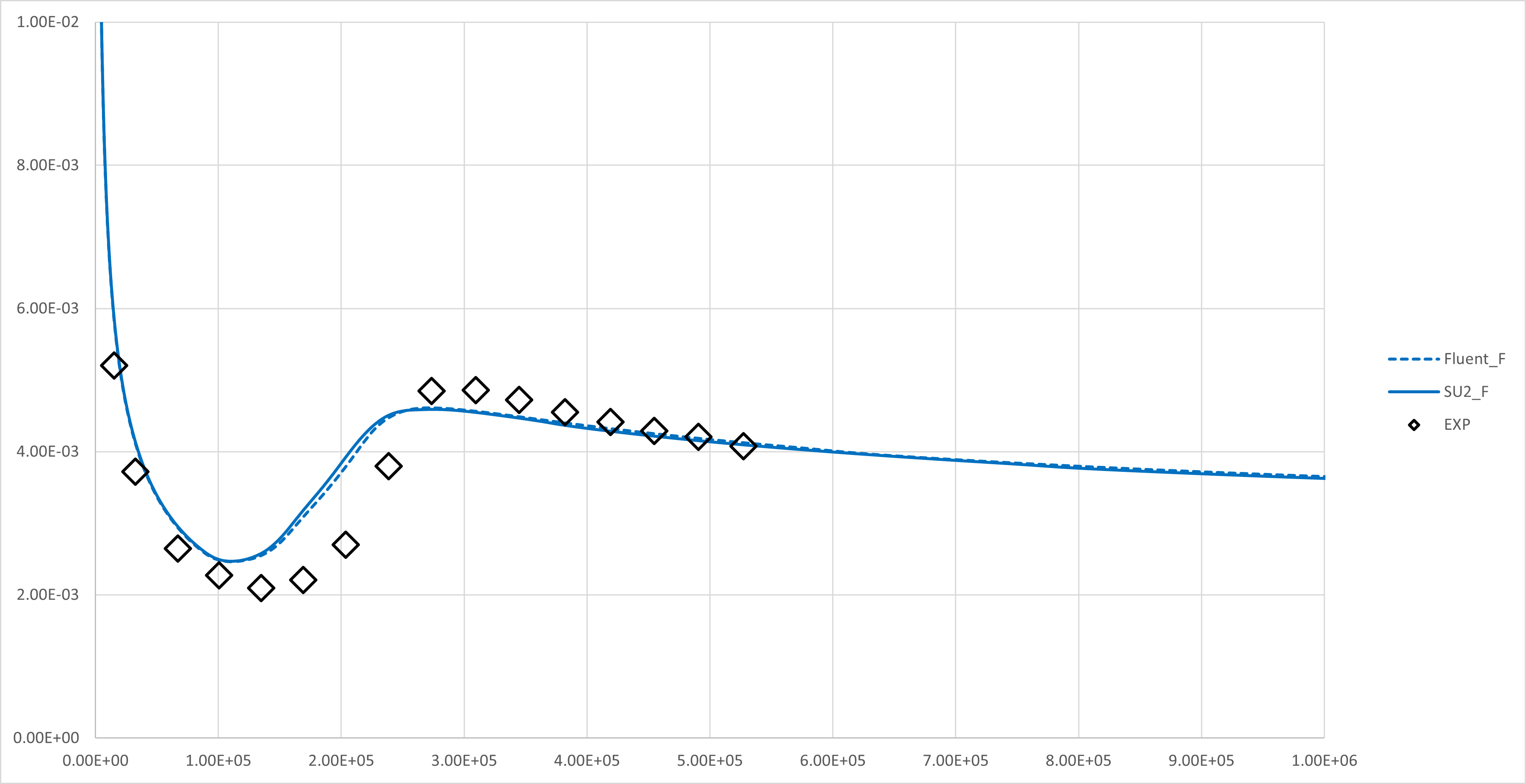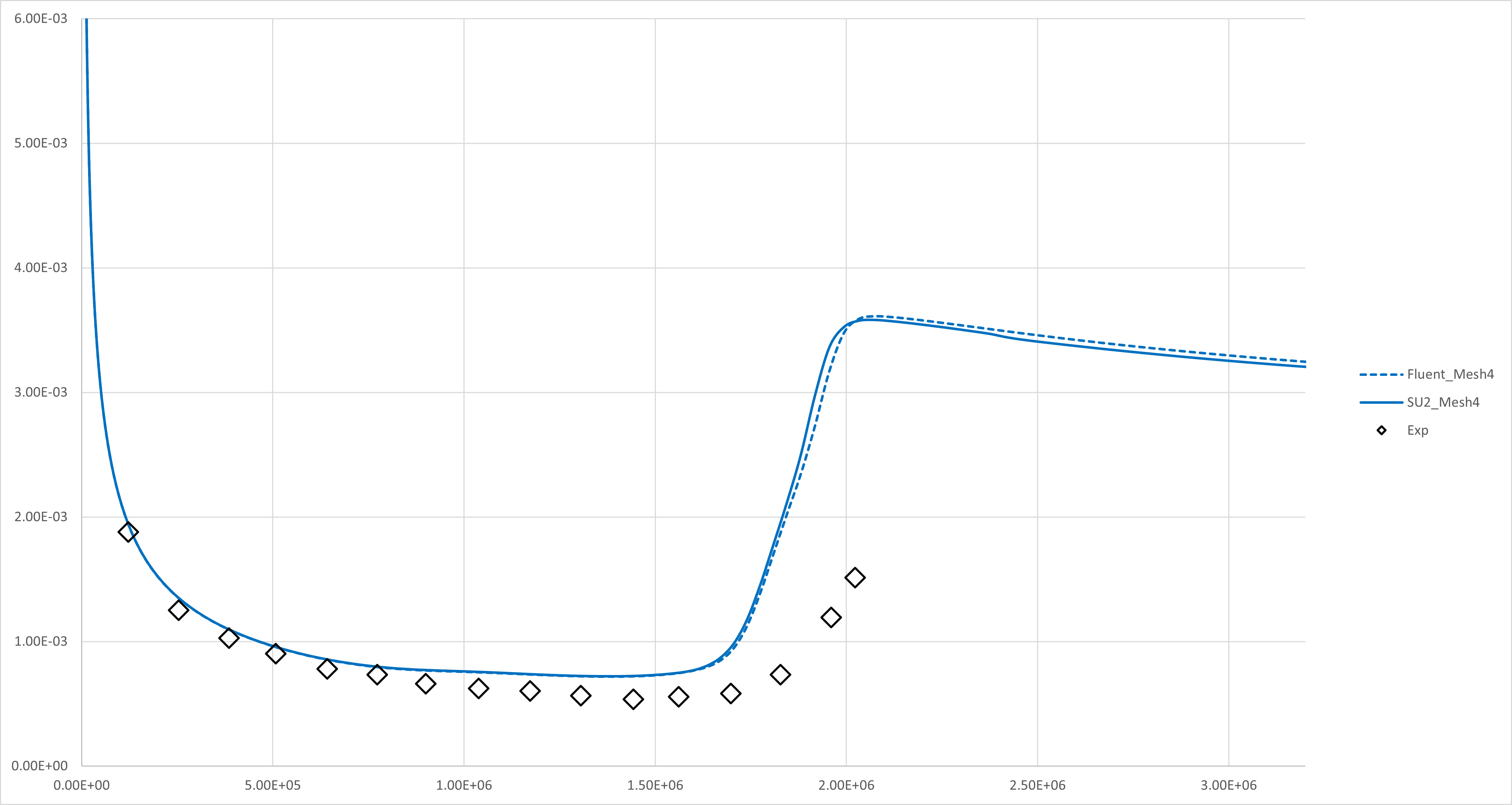-
Inviscid Bump in a Channel
Inviscid Supersonic Wedge
Inviscid ONERA M6
Laminar Flat Plate
Laminar Cylinder
Turbulent Flat Plate
Transitional Flat Plate
Transitional Flat Plate for T3A and T3A-
Turbulent ONERA M6
Unsteady NACA0012
Epistemic Uncertainty Quantification of RANS predictions of NACA 0012 airfoil
Non-ideal compressible flow in a supersonic nozzle
Aachen turbine stage with Mixing-plane
-
Inviscid Hydrofoil
Laminar Flat Plate with Heat Transfer
Turbulent Flat Plate
Turbulent NACA 0012
Laminar Backward-facing Step
Laminar Buoyancy-driven Cavity
Streamwise Periodic Flow
Species Transport
Composition-Dependent model for Species Transport equations
Unsteady von Karman vortex shedding
Turbulent Bend with wall functions
-
Static Fluid-Structure Interaction (FSI)
Dynamic Fluid-Structure Interaction (FSI) using the Python wrapper and a Nastran structural model
Static Conjugate Heat Transfer (CHT)
Unsteady Conjugate Heat Transfer
Solid-to-Solid Conjugate Heat Transfer with Contact Resistance
Incompressible, Laminar Combustion Simulation
-
Unconstrained shape design of a transonic inviscid airfoil at a cte. AoA
Constrained shape design of a transonic turbulent airfoil at a cte. CL
Constrained shape design of a transonic inviscid wing at a cte. CL
Shape Design With Multiple Objectives and Penalty Functions
Unsteady Shape Optimization NACA0012
Unconstrained shape design of a two way mixing channel
Adjoint design optimization of a turbulent 3D pipe bend
Transitional Flat Plate for T3A and T3A-
| Written by | for Version | Revised by | Revision date | Revised version |
|---|---|---|---|---|
| @Sunoh Kang | 7.5.0 | @ |
Solver: |
|
Uses: |
|
Prerequisites: |
None |
Complexity: |
Basic |
Goals
Upon completing this tutorial, the user will be familiar with performing an external, transitional flow over a flat plate. The flow over the flat plate will be laminar until it reaches a point where a transition correlation depending on local flow variables is activated. The results can be compared to the zero pressure gradient natural transition experiment of T3A & T3A-ERCOFTAC. The following capabilities of SU2 will be showcased in this tutorial:
- Steady, 2D, incompressible RANS equations
- k-w SST-2003m turbulence model with Langtry and Menter 2009 (LM2009) transition model
- L2Roe convective scheme in space (2nd-order, upwind)
- Corrected average-of-gradients viscous scheme
- Euler implicit time integration
- farfield, Outlet, Symmetry and No-Slip Wall boundary conditions
Resources
The resources for this tutorial can be found in the compressible_flow/Transitional_Flat_Plate/LM directory in the tutorial repository.
Tutorial
The following tutorial will walk you through the steps required when solving for the transitional flow over a flat plate using SU2. It is assumed you have already obtained and compiled the SU2_CFD code for a serial or parallel computation. If you have yet to complete these requirements, please see the Download and Installation pages.
Background
Practically, most CFD analyses are carried out using fully turbulent fields that do not account for boundary layer transition. Given that the flow is everywhere turbulent, no separation bubbles or other complex flow phenomena evolve. A transition model can be introduced, however, such that the flow begins as laminar by damping the production term of the turbulence model until a point where a transition correlation is activated. Currently, Langtry and Menter transition model (LM) that uses k-w SST-2003m as the baseline turbulence model is implemented in SU2.
For verification, we will be comparing SU2 results against the results of natural transition flat plate experiment of ERCOFTAC. The experimental data include skin friction coefficient distribution versus the local Reynolds number over the flat plate.
Problem Setup
The length of the flat plate is 20 meters, and it is represented by an adiabatic no-slip wall boundary condition. There is a symmetry plane located before the leading edge of the flat plate. far boundary condition is used on the left and top boundary of the domain, and outlet boundary condition is applied to the right boundaries of the domain. Flow condition, you can reference from https://doi.org/10.2514/6.2022-3679.
Mesh Description
The mesh used for T3A tutorial, which provided by AIAA Transition modeling workshop-I. The mesh used for T3A- tutorial, which consists of 122,880 quadrilaterals. Both T3A and T3A- boundary conditions are shown below.

Figure (1): Mesh with boundary conditions (red: far, blue:out, orange:symmetry, green:wall)
Configuration File Options
Several of the key configuration file options for this simulation are highlighted here.
% Physical governing equations (EULER, NAVIER_STOKES,
% WAVE_EQUATION, HEAT_EQUATION,
% LINEAR_ELASTICITY, POISSON_EQUATION)
SOLVER= RANS
%
% Specify turbulent model (NONE, SA, SST)
KIND_TURB_MODEL= SST
%
% Specify versions/corrections of the SST model (V2003m, V1994m, VORTICITY, KATO_LAUNDER, UQ, SUSTAINING)
SST_OPTIONS= NONE
%
% Transition model (NONE, LM)
KIND_TRANS_MODEL= LM
...
%
% Free-stream turbulence intensity
FREESTREAM_TURBULENCEINTENSITY = 0.01
In the LM model, transition onset location is affected by freestream turbulence intensity.
Running SU2
To run this test case, follow these steps at a terminal command line:
-
Copy the (config file) and (mesh file) so that they are in the same directory. Move to the directory containing the config file and the mesh file. Make sure that the SU2 tools were compiled, installed, and that their install location was added to your path.
-
Run the executable by entering
$ SU2_CFD transitional_LM_model_ConfigFile.cfgat the command line.
-
SU2 will print residual updates for each iteration of the flow solver, and the simulation will finish upon reaching the specified convergence criteria.
-
Files containing the results will be written upon exiting SU2. The flow solution can be visualized in Tecplot or ParaView.
Results
The figure below compares the skin friction results obtained by the LM transition model to the result of another solver(=Fluent 19.0) and experimental data.
 Figure (2): Comparison of the skin friction coefficients for the T3A case.
Figure (2): Comparison of the skin friction coefficients for the T3A case.
 Figure (3): Comparison of the skin friction coefficients for the T3A- case.
Figure (3): Comparison of the skin friction coefficients for the T3A- case.
Notes
The LM model is designed using general subsonic transition experiment results(T-S wave, bypass transition, and separation-induced transition). So, This LM model can’t provide appropriate simulation results for crossflow, supersonic, and hypersonic flow transition(= crossflow instability, 1st mode, Mack 2nd mode).